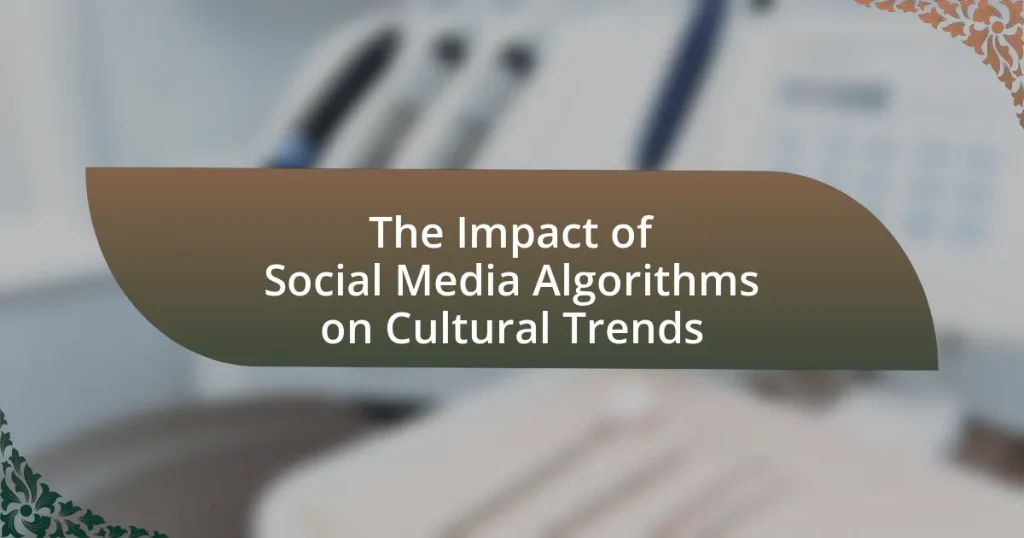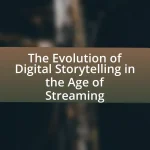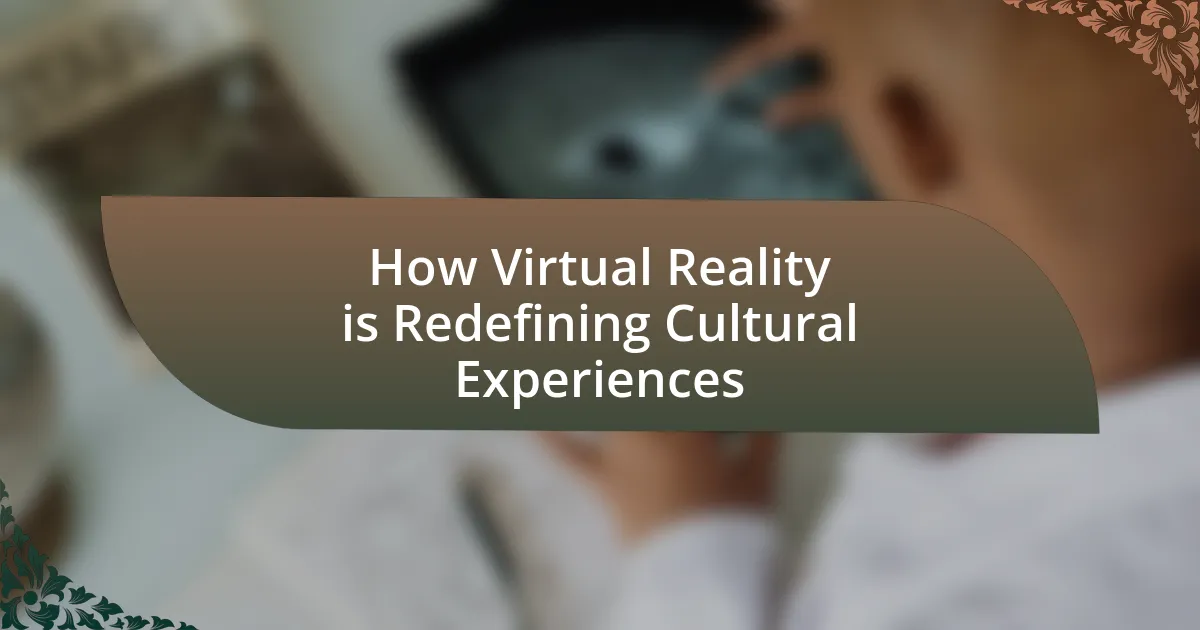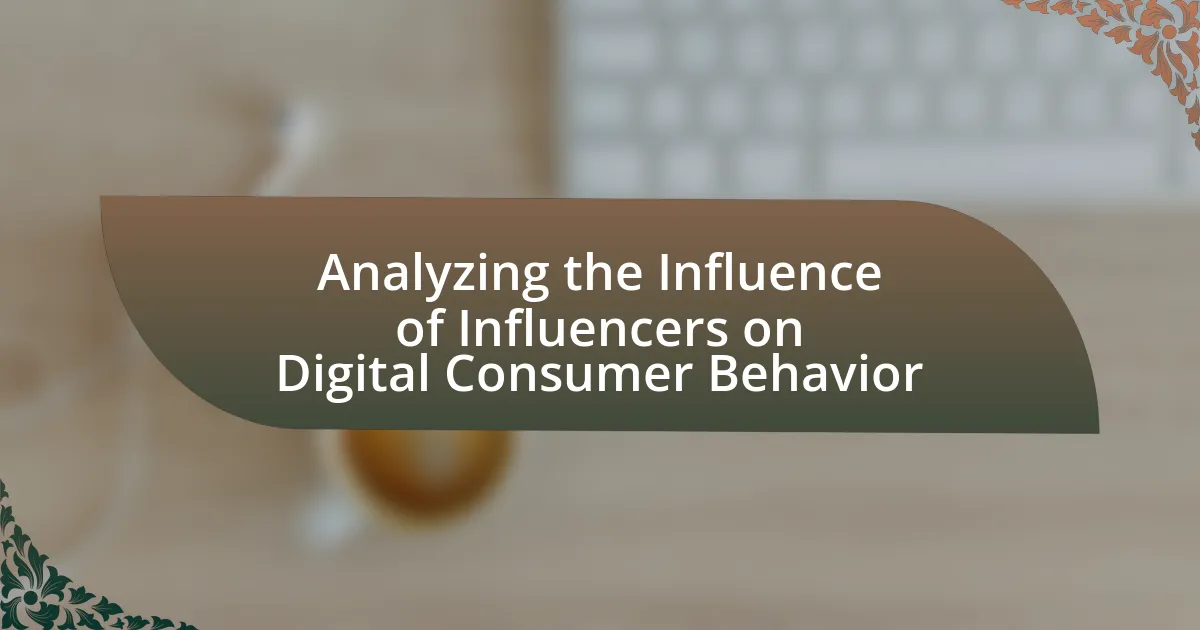Social media algorithms are mathematical formulas that determine the content visibility on platforms based on user preferences and behaviors. These algorithms significantly influence cultural trends by amplifying certain ideas and movements while marginalizing others, as evidenced by the viral spread of social movements and trends. The article explores how algorithms function, their key components, and their impact on user engagement and information dissemination. It also addresses the positive and negative consequences of algorithms on cultural diversity, echo chambers, and the future implications for cultural trends, providing strategies for users to navigate and promote diverse content in algorithm-driven environments.
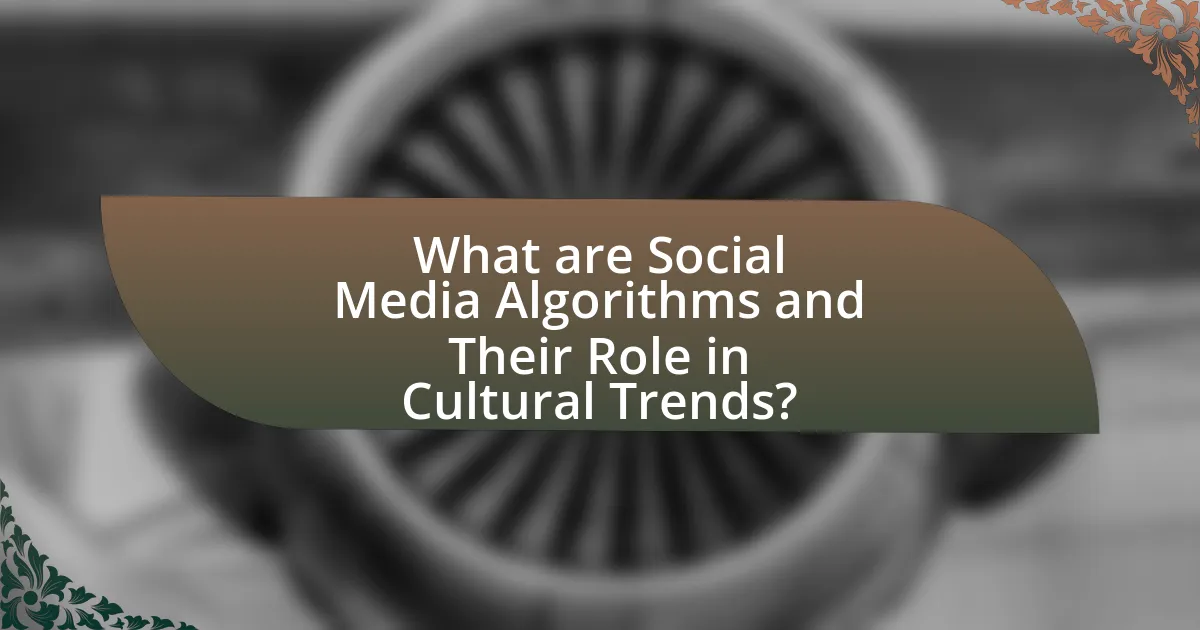
What are Social Media Algorithms and Their Role in Cultural Trends?
Social media algorithms are complex mathematical formulas used by platforms to determine which content is shown to users based on their preferences and behaviors. These algorithms analyze user interactions, such as likes, shares, and comments, to curate personalized feeds that influence what users see and engage with.
The role of these algorithms in cultural trends is significant; they can amplify certain ideas, movements, or content, leading to widespread visibility and adoption. For instance, the viral spread of social movements like #BlackLivesMatter on platforms like Twitter and Instagram demonstrates how algorithms can elevate cultural discussions and shape public opinion. Research indicates that content promoted by algorithms can lead to increased engagement and participation in cultural phenomena, as seen in the rise of TikTok trends that often reflect and influence youth culture.
How do social media algorithms function?
Social media algorithms function by analyzing user data to determine which content is most relevant and engaging for each individual user. These algorithms utilize various factors, including user interactions (likes, shares, comments), content type (videos, images, text), and user demographics to curate personalized feeds. For instance, Facebook’s algorithm prioritizes posts from friends and family, while Instagram’s algorithm emphasizes engagement metrics to surface popular content. This data-driven approach ensures that users are exposed to content that aligns with their interests, thereby influencing cultural trends by amplifying certain narratives and ideas based on collective user behavior.
What are the key components of social media algorithms?
The key components of social media algorithms include user engagement metrics, content relevance, and personalization techniques. User engagement metrics, such as likes, shares, and comments, determine how content is prioritized in a user’s feed. Content relevance is assessed through factors like keywords, hashtags, and trending topics, ensuring that users see posts that align with their interests. Personalization techniques utilize data from user behavior and preferences to tailor content specifically for individuals, enhancing user experience and retention. These components work together to influence what users see, thereby shaping cultural trends on social media platforms.
How do algorithms determine content visibility?
Algorithms determine content visibility by analyzing user engagement metrics, relevance, and personalization factors. These algorithms assess how users interact with content, such as likes, shares, comments, and viewing time, to prioritize posts that are likely to resonate with individual preferences. For instance, Facebook’s algorithm uses a ranking system that considers user interactions and content type to decide what appears in a user’s feed, ensuring that more engaging content is shown first. This method is supported by data indicating that posts with higher engagement rates are more likely to be promoted, thereby influencing cultural trends by amplifying popular content.
Why are social media algorithms significant in shaping cultural trends?
Social media algorithms are significant in shaping cultural trends because they determine the visibility and reach of content, influencing what users see and engage with. These algorithms analyze user behavior, preferences, and interactions to curate personalized feeds, which can amplify certain ideas, movements, or trends while suppressing others. For instance, a study by the Pew Research Center found that 64% of Americans believe social media has a major impact on their views about social issues, highlighting the algorithms’ role in shaping public perception and cultural narratives.
What impact do algorithms have on user engagement?
Algorithms significantly enhance user engagement by personalizing content delivery based on individual preferences and behaviors. This personalization increases the likelihood of users interacting with content, as algorithms analyze past interactions to curate feeds that resonate with users’ interests. For instance, a study by the Pew Research Center found that 64% of social media users report that algorithms help them discover content they find interesting, leading to longer session times and increased interaction rates. Consequently, algorithms play a crucial role in shaping user experiences and driving engagement on social media platforms.
How do algorithms influence the spread of information?
Algorithms significantly influence the spread of information by determining what content is prioritized and shown to users on social media platforms. These algorithms analyze user behavior, engagement metrics, and preferences to curate personalized feeds, which can amplify certain narratives while suppressing others. For instance, a study by the Pew Research Center found that 64% of Americans believe social media platforms have a significant impact on the news they see, indicating that algorithmic choices shape public perception and discourse. Consequently, the design and function of these algorithms can lead to echo chambers, where users are exposed primarily to information that aligns with their existing beliefs, thereby affecting cultural trends and societal norms.
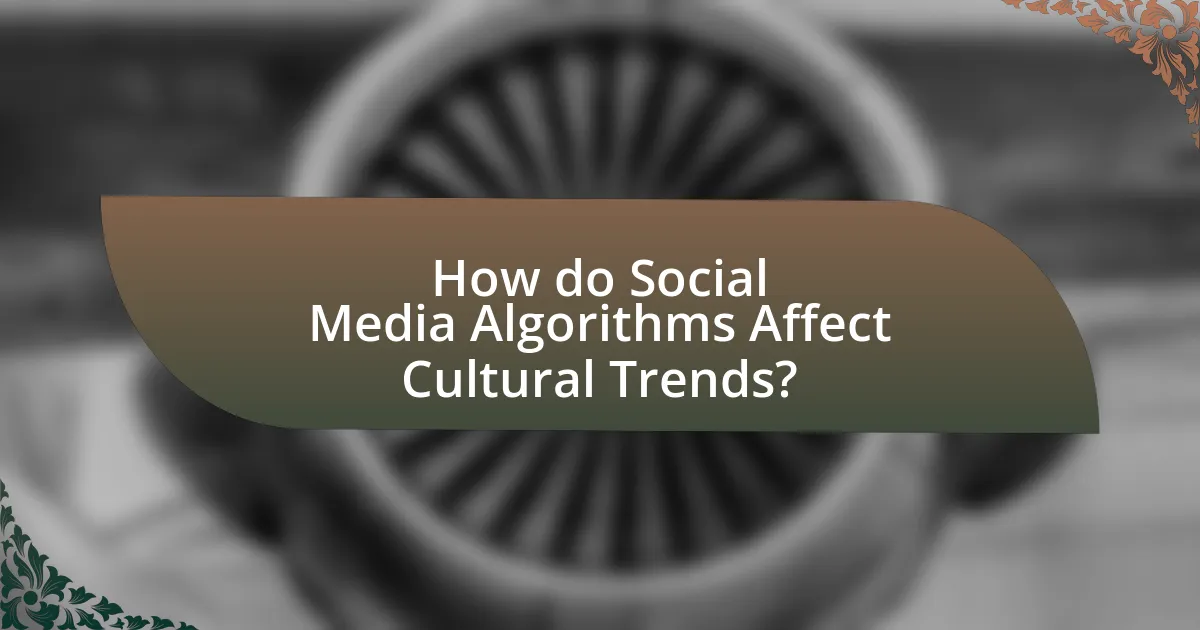
How do Social Media Algorithms Affect Cultural Trends?
Social media algorithms significantly shape cultural trends by determining the visibility and reach of content shared on platforms. These algorithms analyze user behavior, preferences, and interactions to curate personalized feeds, which can amplify specific ideas, movements, or aesthetics while marginalizing others. For instance, a study by the Pew Research Center found that 64% of Americans believe social media has a major impact on their views about social issues, indicating that algorithm-driven content can influence public opinion and cultural narratives. Consequently, the prioritization of certain types of content over others can lead to the rapid spread of trends, such as viral challenges or social movements, while also creating echo chambers that reinforce existing beliefs and limit exposure to diverse perspectives.
What are the positive effects of social media algorithms on culture?
Social media algorithms positively influence culture by enhancing content discovery and fostering community engagement. These algorithms curate personalized feeds that expose users to diverse perspectives and cultural expressions, thereby broadening their understanding of different cultures. For instance, platforms like Instagram and TikTok utilize algorithms to promote trending cultural phenomena, allowing users to engage with global movements such as social justice or environmental awareness. Research indicates that algorithm-driven content can lead to increased participation in cultural dialogues, as evidenced by the rise of hashtags that mobilize communities around shared interests and causes. This engagement not only enriches cultural exchange but also empowers marginalized voices, contributing to a more inclusive cultural landscape.
How do algorithms promote diverse cultural expressions?
Algorithms promote diverse cultural expressions by curating content that reflects a wide range of cultural backgrounds and interests. These algorithms analyze user behavior, preferences, and interactions to recommend content that users may not actively seek but aligns with their latent interests. For instance, platforms like Instagram and TikTok utilize algorithms that prioritize engagement, allowing niche cultural content to reach broader audiences, thereby fostering exposure to various cultural expressions. Research by the Pew Research Center indicates that 64% of social media users have discovered new cultural content through algorithm-driven recommendations, highlighting the role of algorithms in diversifying cultural exposure.
What role do algorithms play in cultural awareness and education?
Algorithms play a crucial role in enhancing cultural awareness and education by curating content that exposes users to diverse perspectives and information. These algorithms analyze user behavior and preferences to recommend educational materials, articles, and cultural content that may not be readily accessible, thereby broadening users’ understanding of different cultures. For instance, platforms like YouTube and Instagram utilize algorithms to promote videos and posts from various cultural backgrounds, which can lead to increased awareness and appreciation of cultural diversity. Research indicates that exposure to diverse cultural content can foster empathy and reduce biases, highlighting the educational potential of algorithm-driven platforms in shaping cultural understanding.
What are the negative consequences of social media algorithms on culture?
Social media algorithms negatively impact culture by promoting echo chambers and misinformation. These algorithms prioritize content that aligns with users’ existing beliefs, leading to a lack of exposure to diverse perspectives. Research indicates that this phenomenon can reinforce polarization, as users become more entrenched in their views, reducing constructive dialogue. Additionally, algorithms often amplify sensational or misleading information, which can distort public understanding of critical issues. A study by the Pew Research Center found that 64% of Americans believe social media has a mostly negative effect on the way things are going in the country today, highlighting widespread concern about the cultural implications of algorithm-driven content.
How do algorithms contribute to cultural homogenization?
Algorithms contribute to cultural homogenization by prioritizing content that aligns with popular trends, thereby reducing the diversity of cultural expressions. Social media platforms utilize algorithms to analyze user behavior and engagement, promoting similar content across vast audiences. This leads to a feedback loop where widely accepted ideas and trends are amplified, while niche or less popular cultures receive diminished visibility. For instance, a study by the Pew Research Center found that 64% of Americans believe social media has a mostly negative effect on the way things are going in the country, indicating a concern over the narrowing of cultural perspectives due to algorithmic filtering.
What are the risks of echo chambers created by algorithms?
Echo chambers created by algorithms pose significant risks, including the reinforcement of misinformation and polarization of opinions. These algorithms prioritize content that aligns with users’ existing beliefs, leading to a lack of exposure to diverse perspectives. Research indicates that individuals within echo chambers are more likely to accept false information as truth, as demonstrated by a study published in the journal “Science” which found that misinformation spreads more rapidly in homogeneous groups. Additionally, echo chambers can exacerbate societal divisions, as users become increasingly isolated from differing viewpoints, ultimately hindering constructive dialogue and understanding.
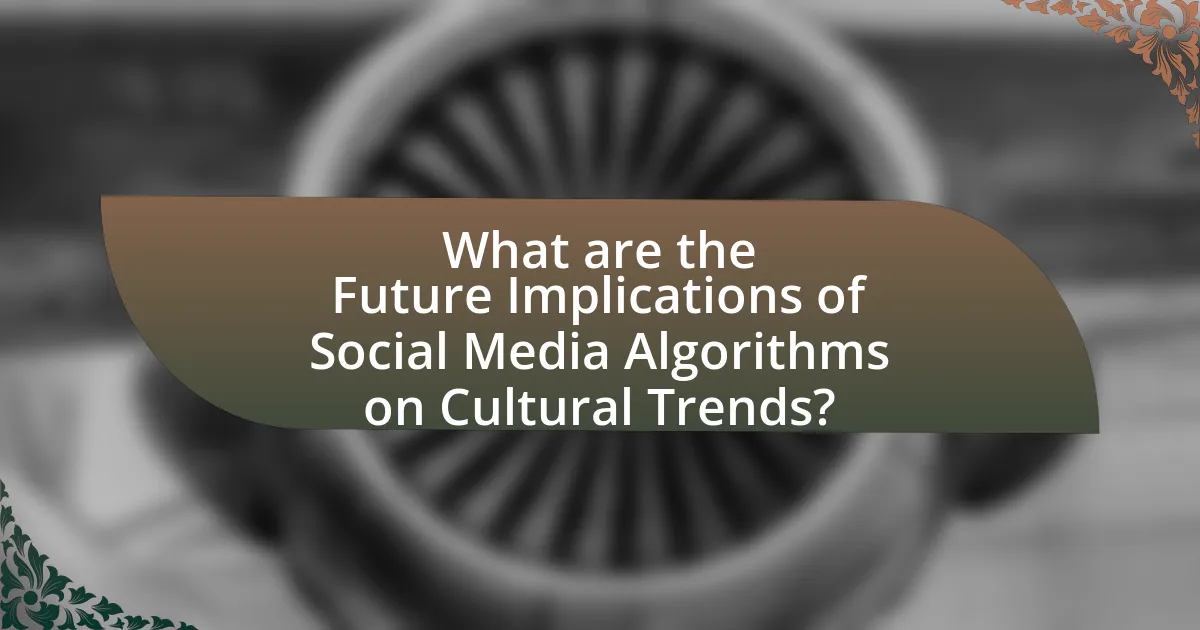
What are the Future Implications of Social Media Algorithms on Cultural Trends?
Social media algorithms will increasingly shape cultural trends by prioritizing content that aligns with user preferences, leading to the reinforcement of echo chambers and the homogenization of cultural expressions. As algorithms analyze user behavior, they promote content that generates engagement, often sidelining diverse perspectives and niche interests. Research indicates that platforms like Facebook and Instagram have already influenced political discourse and social movements by amplifying specific narratives while suppressing others, as seen in the 2016 U.S. presidential election where algorithmic bias played a significant role in information dissemination. Consequently, the future will likely see a further entrenchment of these dynamics, potentially stifling cultural diversity and fostering polarization within societies.
How might social media algorithms evolve in the coming years?
Social media algorithms are likely to evolve towards greater personalization and enhanced user engagement in the coming years. This evolution will be driven by advancements in artificial intelligence and machine learning, enabling platforms to analyze user behavior more effectively and tailor content to individual preferences. For instance, algorithms may increasingly prioritize content that aligns with users’ emotional responses, as evidenced by studies showing that emotionally charged posts generate higher engagement rates. Additionally, there is a trend towards transparency and ethical considerations, with platforms implementing features that allow users to understand how their data influences content curation. This shift is supported by growing public demand for accountability in data usage, as highlighted by the Cambridge Analytica scandal, which prompted calls for more responsible algorithmic practices.
What technological advancements could influence algorithm development?
Technological advancements such as artificial intelligence, machine learning, and big data analytics significantly influence algorithm development. These technologies enable algorithms to process vast amounts of data, identify patterns, and improve decision-making processes. For instance, machine learning algorithms can adapt and optimize based on user interactions, enhancing personalization in social media feeds. Additionally, advancements in natural language processing allow algorithms to better understand and interpret user-generated content, leading to more relevant content recommendations. The integration of these technologies has been shown to increase user engagement and satisfaction, as evidenced by studies indicating that personalized content can boost user interaction rates by up to 50%.
How might user behavior change in response to algorithm updates?
User behavior may change significantly in response to algorithm updates by altering content consumption patterns and engagement levels. When algorithms prioritize different types of content, users often adapt by seeking out new sources or formats that align with the updated recommendations. For instance, a study by the Pew Research Center found that 64% of social media users reported changing their content preferences based on algorithmic suggestions, indicating a direct correlation between algorithm updates and user behavior shifts. Additionally, users may increase their interaction with trending topics or formats that the algorithm favors, leading to a rapid evolution in cultural trends as they respond to the new visibility of certain content types.
What strategies can users employ to navigate algorithm-driven cultural trends?
Users can employ several strategies to navigate algorithm-driven cultural trends effectively. First, diversifying content consumption across multiple platforms helps mitigate the echo chamber effect created by algorithms that prioritize similar content. Research indicates that exposure to varied viewpoints enhances critical thinking and cultural awareness. Second, actively engaging with content by liking, sharing, or commenting can influence algorithms to present a broader range of topics, thus allowing users to shape their feeds. Third, utilizing tools like content aggregators or curated feeds can provide a more balanced perspective by filtering out algorithmic biases. Lastly, being aware of algorithmic mechanics, such as how engagement metrics influence visibility, empowers users to make informed choices about their online interactions. These strategies collectively enable users to navigate and critically assess the cultural trends shaped by social media algorithms.
How can individuals promote diverse content in algorithmic feeds?
Individuals can promote diverse content in algorithmic feeds by actively engaging with a variety of content types and creators. This engagement includes liking, sharing, and commenting on posts from different cultural backgrounds, perspectives, and genres. Research indicates that user interactions significantly influence algorithmic recommendations; for instance, a study by the Pew Research Center found that diverse engagement can lead to a broader range of content being surfaced in feeds. By consistently interacting with diverse content, individuals can help shift algorithmic biases that often favor popular or homogeneous material, thereby fostering a richer cultural landscape online.
What best practices should users follow to mitigate negative algorithm effects?
Users should diversify their content consumption to mitigate negative algorithm effects. By actively seeking out a variety of sources and perspectives, users can counteract the echo chamber effect often created by algorithms that prioritize familiar content. Research indicates that exposure to diverse viewpoints can enhance critical thinking and reduce polarization, as shown in studies like “The Filter Bubble: What the Internet Is Hiding from You” by Eli Pariser, which highlights how algorithms can limit exposure to differing opinions. Additionally, users should regularly adjust their engagement patterns, such as liking, sharing, or commenting on a broader range of topics, to signal to algorithms that they desire varied content. This practice can help recalibrate algorithmic recommendations, promoting a healthier and more balanced media diet.
